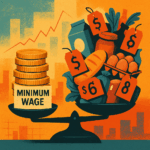For millions across the United Kingdom, Universal Credit has long stood as a lifeline—an essential system meant to catch individuals and families when they fall. But recent reforms and strategic cuts are rapidly transforming this safety net into something more fragile, uncertain, and, in many cases, ineffective. As the government introduces structural changes aiming to streamline welfare support, those at the receiving end are experiencing not efficiency, but exclusion. The rhetoric of reform, cloaked in fiscal responsibility and economic stimulation, often conceals the harsh consequences felt by vulnerable households navigating daily realities of food insecurity, energy debt, and unstable housing.
What’s unfolding is more than a policy shift—it’s a reshaping of the very definition of public assistance. The promise behind Universal Credit was simplicity: a single monthly payment replacing six legacy benefits, modernized and accessible. Yet the latest wave of changes has opened a chasm between political intention and lived experience. As eligibility thresholds tighten and benefit sanctions become more aggressively enforced, individuals are finding themselves trapped not by dependency, but by the very mechanisms that were supposed to help them escape poverty. This is a human story, not just a bureaucratic one, and it’s happening in quiet, invisible corners of society every day.
The changing face of welfare: what reforms really mean

The government’s justification for revising Universal Credit often revolves around the need to “incentivize work” and ensure that welfare doesn’t become a long-term crutch. These talking points have formed the backbone of policy changes over the past year, including stricter work search requirements, reduced allowances for certain groups, and increased surveillance on spending patterns. In theory, these measures aim to encourage independence and reduce the overall cost of welfare to taxpayers. But in practice, they tend to punish those who are already struggling the most.
One of the most controversial aspects has been the narrowing of eligibility. The minimum income floor, for example, has affected self-employed individuals disproportionately, especially those in the gig economy or with irregular earnings. Simultaneously, single parents and disabled individuals face higher thresholds to receive full benefits. For them, being excluded from Universal Credit doesn’t translate into finding work quickly—it leads to greater financial precarity and a reliance on food banks or informal loans. There’s an inherent contradiction in designing a welfare system that assumes opportunity is equally accessible while ignoring the structural barriers many face in employment, education, and health.
Moreover, the language used in policy documentation has taken on a more punitive tone, with terms like “compliance” and “enforcement” replacing earlier narratives of “support” and “transition.” This linguistic shift isn’t just cosmetic—it reflects a deeper ideological transformation. Welfare is increasingly seen not as a shared societal responsibility but as an individual failure to be corrected. For recipients, this can create feelings of shame and invisibility, further eroding their mental and emotional stability. The psychological toll of navigating a hostile system cannot be overstated.
Everyday impact: families, work, and impossible choices
Behind each policy change are human lives recalibrated around impossible choices. Take, for example, a single mother working part-time in retail. With the cuts to the work allowance and increased childcare obligations tied to benefits, she may have to choose between feeding her children and paying rent. For those with disabilities, even minor changes in assessment criteria can lead to a complete loss of financial support, sometimes overnight. The knock-on effects are catastrophic: eviction, mental health crises, and spiraling debt. The welfare state was once designed to buffer such shocks—but now, it’s often the cause.
For working claimants, the concept of “in-work poverty” has become disturbingly normalized. These are people who contribute to the economy yet cannot afford basic needs due to low wages and high living costs. Universal Credit was meant to top up their income, but payment delays, sanctions, and arbitrary calculations have created a gap between need and assistance. It’s not uncommon for a claimant to be told they’ve been overpaid—through no fault of their own—and are now required to repay hundreds of pounds. The emotional whiplash of this system undermines trust, not only in the welfare apparatus but in government more broadly.
In addition, digital exclusion continues to be a significant barrier. The push toward an online-only application and management system assumes digital literacy and stable internet access, both of which are lacking in many rural or low-income households. For the elderly or those with disabilities, the interface can be not just confusing, but entirely inaccessible. It’s a system that rewards those who can navigate bureaucracy quickly and penalizes those who can’t, regardless of how much they need help. This technological divide widens the gap between policy on paper and its real-world accessibility.
The road ahead: is there hope for a humane welfare system?
While criticism mounts from social justice organizations, charities, and even local councils, the question remains: can Universal Credit be reimagined into a more compassionate and functional model? There are glimpses of hope. Pilot programs experimenting with Universal Basic Income (UBI), guaranteed minimum income, or non-conditional welfare in other countries are offering a vision of what inclusive support could look like. In Scotland, for instance, child payments and devolved social security measures have proven more responsive to local needs, demonstrating that a one-size-fits-all model doesn’t serve everyone equally.
Activists and grassroots coalitions are also pushing back with data, stories, and legal challenges. The “Right to Food” campaign, community kitchens, and benefit rights groups are documenting the tangible impact of reforms and holding policymakers accountable. These movements are not just reactive—they’re building frameworks rooted in dignity, equity, and trust. More than ever, there is an urgent need to place lived experience at the center of welfare reform, not at its margins.
At the political level, meaningful change would require a shift away from austerity logic and toward a model that views social benefits as investments in human potential. This would mean not just increasing benefit amounts, but removing punitive sanctions, eliminating arbitrary assessments, and ensuring timely payments. Most importantly, it demands a cultural change—a willingness to acknowledge that needing help is not a moral failure but a natural part of life’s unpredictability. Until such a transformation occurs, the gap between intention and impact will only grow wider.


